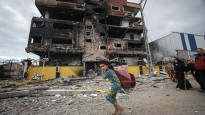The cease-fire is scheduled to begin in Gaza at seven in the morning.
The distress of civilians in Gaza is enormous as the war continues for the seventh week. According to the administration of the terrorist organization Hamas, 14,854 people had died in the bombings by Thursday.
There are 6,150 of the dead children. On Thursday, the UN children’s organization Unicef drew attention to the crisis with a statement that Gaza is the most dangerous place in the world for children.
The number of child victims has been In Gaza, exceptionally largeif it is compared to, for example, the wars in Syria, Afghanistan and Iraq.
There have been tens of thousands of wounded in Gaza.
The UN World Health Organization WHO considers the casualty figures reported by the Gaza health authority to be reliable. There are practically no other estimates of the number of victims available.
While the number of victims is increasing, medical care has completely collapsed in northern Gaza. Israel has bombed near hospitals, and as of the beginning of the week, according to the UN, there was only one hospital in operation in the area.
Israel has justified the attacks by saying that Hamas has military targets near the hospitals or in the tunnels under them.
Israeli forces control most of the northern part of Gaza. A large part of the inhabitants of the northern part of Gaza has fled to the south. More than two-thirds of Gaza’s 2.3 million inhabitants have been forced to flee their homes.
Only foreign nationals and a small number of those seriously wounded in the bombings have been allowed out of Gaza. The most recent attention was the transport of 28 premature babies through the Rafah border crossing to Egypt on Monday.
According to Qatar, which acted as mediator, Israel has promised to allow aid deliveries to Gaza during the ceasefire. However, details of the aid transports were not disclosed when the agreement was announced.
International organizations say being ready to deliver thousands of truckloads of food, water and relief supplies if the ceasefire materialises.
During the war, Israel has severely limited aid transports – especially the export of fuel.
In Gaza, there is a shortage of almost everything: food, water, medicine and fuel. According to the UN, before the ongoing war, an average of approx 500 truck-based relief transports. Even before the war, a large part of Gazans depended on aid.
Much of northern Gaza and Gaza City have already been destroyed. of The Financial Times according to the analysis of satellite images commissioned by the Ministry of Defense, approximately half of the buildings in the area had been destroyed or damaged by Israeli bombing already a week ago.
About 30,000 buildings had been damaged in Gaza City. After this, there has been more destruction, as Israel has continued its airstrikes and ground attack. Before the war, about 600,000 people lived in Gaza City.
The southern part of Gaza has also suffered significant damage. There, about a tenth of the building stock had been destroyed or damaged by November 18.
The conflict began when Hamas terrorists attacked Israel on October 7, killing around 1,200 people and taking around 240 hostages. After that, Israel started retaliatory strikes on Gaza.
As part of the ceasefire agreement, Hamas has promised to release 50 hostages. In return, Israel has promised to release 150 Palestinians from their prisons.
In this article, we follow the latest events of the Gaza war
